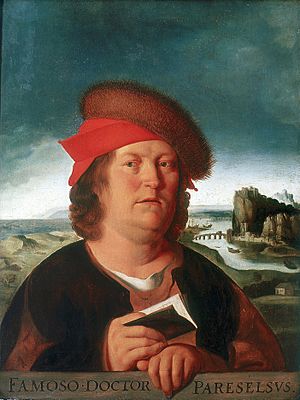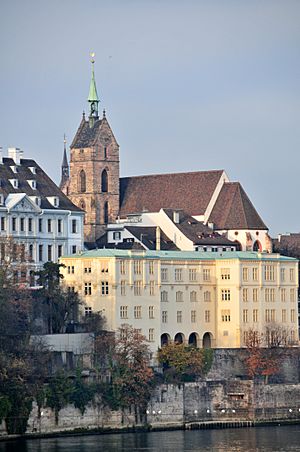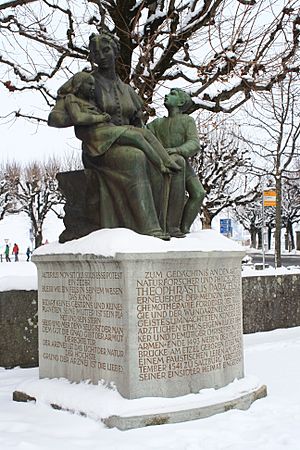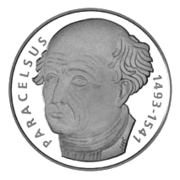Paracelsus facts for kids
Quick facts for kids
Paracelsus
|
|
|---|---|

Paracelsus
|
|
| Born |
Theophrastus von Hohenheim
1493 or 1494 Egg, near Einsiedeln, Schwyz (present-day Switzerland)
|
| Died | 24 September 1541 (aged 47) Salzburg, Archbishopric of Salzburg (present-day Austria)
|
| Other names | Aureolus Philippus Theophrastus, Doctor Paracelsus |
| Alma mater | University of Ferrara |
| Era | Renaissance philosophy |
| Region | Western philosophy |
| School | Renaissance humanism |
|
Notable ideas
|
Toxicology "The dose makes the poison" |
|
Influences
|
|
|
Influenced
Franciscus Sylvius, Sir Thomas Browne, Adam Haslmayr, Gabriel François Venel (disputed), Jane Bennett, Giorgio Agamben |
|
Paracelsus (born between 1493 and 1494 in Einsiedeln, Switzerland – died 1541 in Salzburg, Austria) was a famous Swiss physician. He was also an alchemist, astrologer, and a thinker interested in hidden knowledge. His real name was Theophrastus von Hohenheim.
The name "Paracelsus" was a nickname. It meant "equal to or greater than Celsus", who was a well-known Roman doctor. This nickname showed how skilled Paracelsus was in medicine. He is known for creating laudanum, a medicine made from herbs and alcohol. This medicine was used for a long time, even into the 1800s.
Paracelsus wrote many books. One of his most important works was about diseases that miners got. He studied how different minerals and metals affected the human body. He also wrote about the human body, disagreeing with older ideas from a famous doctor named Galen. Paracelsus believed that observing things was very important for learning. He is often called the "father of toxicology" because of his work with poisons and medicines.
Contents
Early Life and Education
Paracelsus was born in a small village called Egg an der Sihl. This village was near Einsiedeln in Schwyz, Switzerland. His father, Wilhelm, was also a chemist and a doctor.
Paracelsus's mother likely died around 1502. After this, his father moved to Villach, in Carinthia. There, his father continued to work as a doctor. Paracelsus learned a lot from his father. He studied botany (plants), medicine, mineralogy (minerals), mining, and natural philosophy.
When he was 16, Paracelsus began studying medicine. He started at the University of Basel and later moved to Vienna. He earned his medical doctorate degree. This happened at the University of Ferrara in Italy, around 1515 or 1516.
Travels and Early Career
Paracelsus wanted to gain knowledge that wasn't just from books. So, from 1517 to 1524, he traveled a lot around Europe. He visited many countries like Italy, France, Spain, and Germany. He also went to places like Russia, Hungary, and possibly even Egypt.
During his travels, Paracelsus worked as an army surgeon. He was involved in wars fought by different groups. After his many journeys, Paracelsus returned home in 1524. He settled in Salzburg to practice medicine. He stayed there until 1527.
Teaching in Basel

In 1527, Paracelsus became a licensed doctor in Basel. He also got the chance to teach at the University of Basel. Basel was a center for new ideas during the Renaissance. Here, Paracelsus met important thinkers like Erasmus of Rotterdam.
Paracelsus did something unusual for his time. He gave his university lectures in German, not Latin. He wanted everyone to understand his lessons, not just scholars. He also strongly criticized other doctors and pharmacists in Basel. This caused a lot of trouble, and his life was even threatened.
To show his strong disagreement with old medical ideas, Paracelsus publicly burned books. He burned copies of works by Galen and Avicenna. These were very old and respected medical texts. He believed that only those who practiced medicine truly understood it. He famously said, "The patients are your textbook, the sickbed is your study." Because of his bold actions, people compared him to Martin Luther. In 1528, Paracelsus left Basel and moved to Alsace.
Later Years and Legacy

Paracelsus did not stay long in Alsace. He moved to Nuremberg in 1529. However, his reputation for challenging old ideas made it hard for him to practice medicine there. He then moved to Beratzhausen.
It was around this time that the name Paracelsus first appeared. He used it as a pen name for some of his writings. In Beratzhausen, he wrote Paragranum, a major work on his medical philosophy. He then moved to St. Gall and finished another important book, Opus Paramirum, in 1531.
From St. Gall, he went to the land of Appenzell. There, he worked as a healer among the local people. He also visited mines in Schwaz and Hall to study miners' diseases. He continued to travel, visiting places like Meran and St. Moritz. He praised St. Moritz for its healing springs.
His book Astronomia magna was finished in 1537. It was published much later, in 1571. This book discussed topics like hermeticism, astrology, and theology. It helped build his fame as a "prophet." His personal motto was "Let no man belong to another who can belong to himself."
Death and Influence
In 1541, Paracelsus moved to Salzburg, where he died on September 24. He was first buried in a cemetery. Later, in 1752, his remains were moved inside St. Sebastian's church.
After his death, many people were inspired by his ideas. This led to a medical movement called Paracelsianism. His methods became more widely known and used. Many of his writings were published after he died. His books were often reprinted and widely read in the late 1500s and early 1600s. Even though some of his ideas were seen as unusual, his medical contributions were recognized. A book of medicines published in London in 1618 included "Paracelsian" remedies.
Paracelsus's Philosophy
Astrology was a big part of Paracelsus's medicine. Like many doctors of his time, he was an astrologer. He wrote about making astrological charms to help cure diseases. He accepted the idea of the four elements—water, air, fire, and earth. But he saw them as a base for other important properties.
Paracelsus used an egg to explain his ideas about elements. He said the air around the world was like an eggshell. The egg white was like fire, holding up the earth and water. The earth and water were like the yolk, forming a globe.
His scientific approach was strongly connected to his religious beliefs. He thought science and religion could not be separated. He believed that scientific discoveries were messages from God. He felt it was humanity's duty to understand these messages.
Contributions to Medicine

Chemistry in Medicine
Paracelsus was one of the first medical professors to say that doctors needed to know a lot about natural sciences. He especially stressed the importance of chemistry. He was a pioneer in using chemicals and minerals in medicine.
He is likely the first person to give the element zinc its modern name around 1526. He probably named it after the sharp, pointed shape of its crystals. Paracelsus also started the idea of chemical therapy. He suggested a chemical theory for how digestion works. He used chemistry in his teaching for medical students.
Paracelsus unknowingly saw hydrogen in the early 1500s. He noticed that when acids reacted with metals, a gas was produced. Later, in 1650, another scientist repeated this. He found that the gas was flammable. However, neither of them realized it was a new element.
Body and Nature
Paracelsus believed that the body's health depended on a balance between humans (microcosm) and nature (macrocosm). He thought that humans needed certain minerals in their bodies. He also believed that illnesses could be cured with chemical remedies.
He thought that the universe was reflected in every person. For example, he used the doctrine of signatures. This idea suggested that if a plant looked like a body part, it could cure that part.
Paracelsus believed that true anatomy meant understanding how each body part was nourished. He also thought that diseases came from "poisons" from the stars. But for him, "poisons" weren't always bad. He famously said, "The dose makes the poison." This means that even good substances can be harmful in large amounts. He also believed that "like cures like." If a star or poison caused a disease, another star or poison could cure it. He thought that useful medicines could be found in herbs, minerals, and chemical mixes.
New Ideas for Treatments
The ancient Greek doctor Hippocrates thought illnesses were caused by an imbalance of four "humours" in the body. These were blood, phlegm, black bile, and yellow bile. Galen developed these ideas further. They were very influential until the mid-1800s.
Paracelsus had a different idea. He believed in three "humours": salt (for stability), sulphur (for burning), and mercury (for liquids). He said disease happened when one humour separated from the other two. He thought body organs worked like alchemists, separating pure from impure.
In Paracelsus's time, common treatments included special diets and bloodletting. Doctors would remove blood to restore the balance of humours. Paracelsus disagreed with this. He thought illnesses came from outside the body. He also said that too much bloodletting harmed the body's balance. He believed that fasting could help the body heal itself. He called fasting "the greatest remedy, the physician within."
Paracelsus helped start modern clinical diagnosis. He also promoted using very specific medicines. He suggested that diseases were actual things, not just states of being. He recommended using iron for "poor blood." He is also credited with creating the terms "chemistry," "gas," and "alcohol."
Toxicology Studies
Paracelsus was very interested in chemistry and biology. This led him to study what we now call toxicology. He believed that diseases affected specific organs. He also thought that chemicals would have their strongest effect in a certain part of the body.
Paracelsus encouraged using animals for experiments. This helped study both the good and bad effects of chemicals. He was one of the first scientists to bring chemistry into medicine. He supported using inorganic salts, minerals, and metals as medicines. He believed that organs in the body separated pure substances from impure ones. Humans eat both pure and impure things to live. The organs' job is to separate the impure from the pure.
Mind and Body Connection
Paracelsus was one of the first doctors to suggest a link between mental well-being and physical health. He thought that a person's state of mind could both cause and cure diseases. He believed that people could stay healthy through strong will.
He also stated that success in a craft depended on a person's character. For example, he thought a doctor with bad intentions would eventually fail. He believed that evil could not lead to true success. For mental illness, Paracelsus emphasized the importance of sleep and calming medicines. He thought these could help heal mental sickness.
Images for kids
See also
 In Spanish: Paracelso para niños
In Spanish: Paracelso para niños



